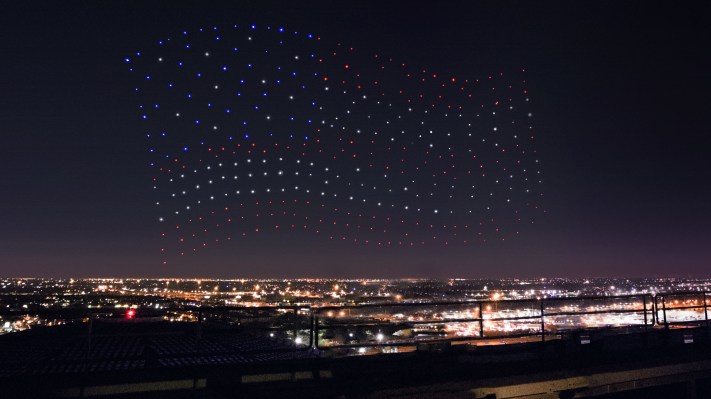There were 300 drones dancing behind Lady Gaga during the Super Bowl halftime show. They’re called Shooting Stars and were previously used in a holiday show at Disney World. These hundreds of Shooting Star drones flash, fall and flock in unison and are all controlled by one person — or rather one computer.
This is the latest project in Intel’s quest to take drones from individuals to fleets. This is Ender’s Game brought to life. Just as in Orson Scott Card’s book, one person commands the group, sending instructions and monitoring the drones’ health. And Intel says its limitless in its scale, able to control more than 10,000 drones at a time.
One of the secret to Intel’s Shooting Star program is a desktop software suite of programs. The drones’ routes are pre-programmed and each drone does its own thing. The drones do not talk to each other and they lack the hardware to detect collisions. The software determines routes that eliminates collisions.
The drones are simple. They’re about the weight of a volleyball. The housing is Styrofoam and there are simple metal cages around the four props. They are designed to be assembled in less than 15 minutes and Intel builds the drones in a facility in Germany. There are no screws and everything snaps together. And then on the bottom of the drone is the large, multicolored LED light that paints the sky.
[gallery ids="1416714,1416715,1416713,1416542"]
Intel turned to Disney to first showcase the technology and in December I got a behind the scenes look at the program prior to its first show. The show itself is neat, as everyone who watched the Super Bowl saw, but the most impressive part wasn’t broadcasted on TV. The drones take off from launchpads like fireflies.
Several drones sit an inch apart on each launchpad. The Shooting Star drones rest in divots designed to cup the round LED housing, which also features the charging contacts for the drones. And they take off, en masse. One after another, seemingly randomly throughout the cluster of launchpads. A quick moment separates each launch as the drones take their position in the air prior to the show.
At the Disney show, Intel had twice the amount of drones on site and ready to fly resulting in 600 drones sitting on these launchpads. The software determines which drones are best charged and ready for flight.
Intel has been working on this program for the past two years. In late 2015 Intel partnered with small group of artists and technology researchers at Ars Electronica Futurelab in Linz, Austria, and sent 100 drones into the air. Four pilots controlled the 100 drones, that launched from four different airfields. Then in late 2016, prior to the first show at Disney World, Intel demonstrated a new generation of the platform, launching 500 drones at once.
Intel envisions a future where drones fly in fleets to accomplish tasks. The same software that Intel and Disney are using to put on a colorful aerial show could be used in search and rescue operations or inspecting equipment and goods. Imagine a squadron of several drones using scanning software — like Intel’s RealSense platform — to inspect an airplane or water tower. Or a force of these drones creating a floating LED screen. But right now the drones are simply flying backup dancers.
Intel and Disney Paint The Sky
